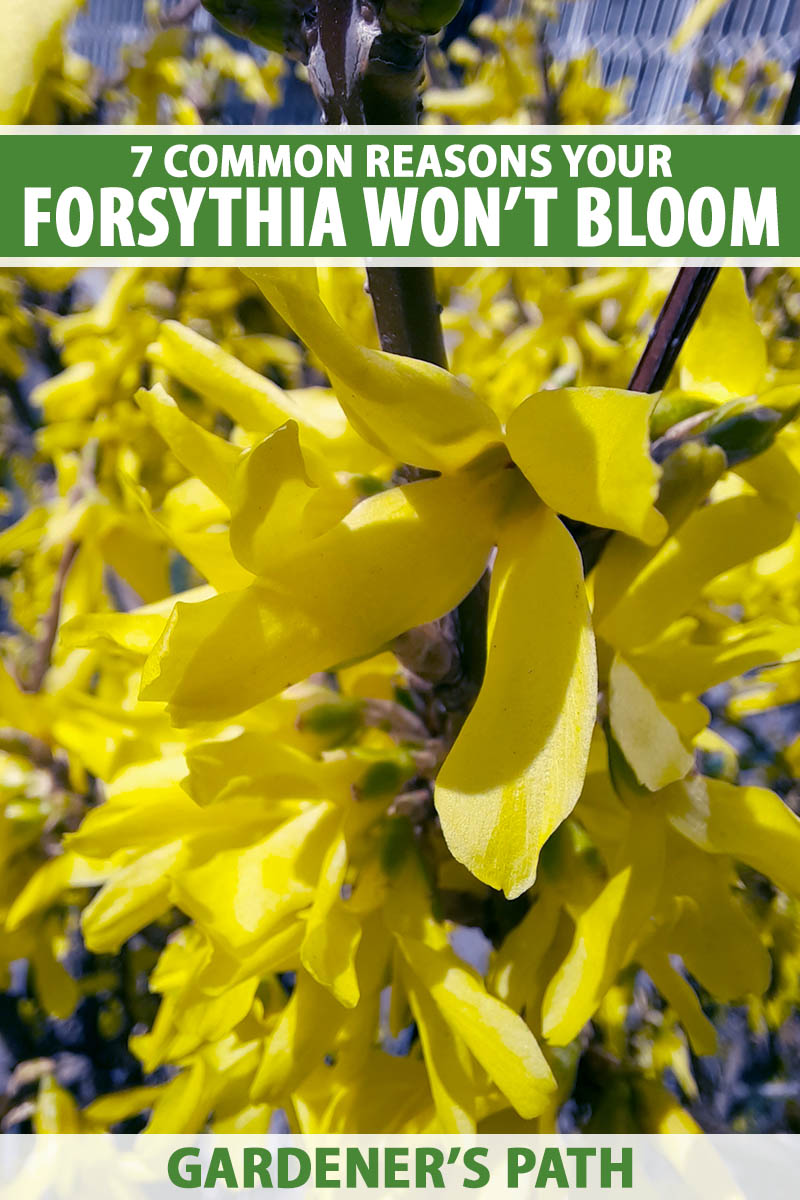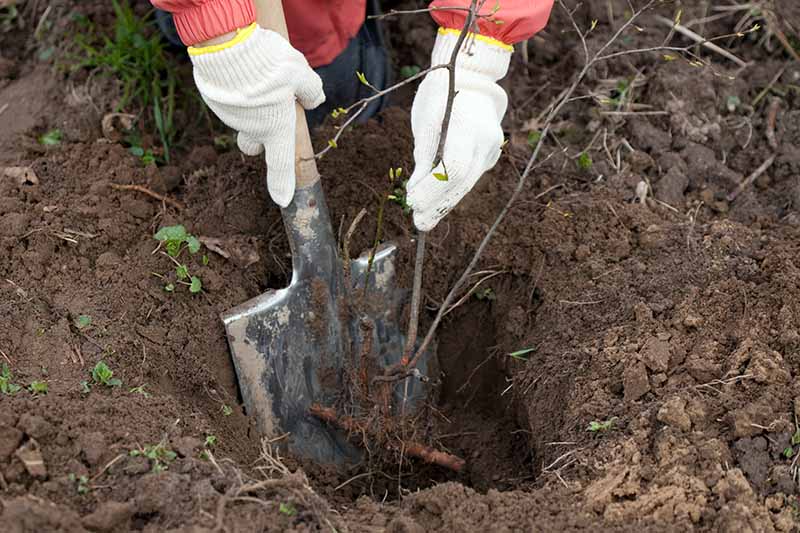The Forsythia genus contains 11 species best known for putting on a spectacular display of bright yellow blossoms in early spring, when many other plants have yet to awaken from their winter dormancy.

For instructions on how to cultivate this easy-to-grow, vigorous, woody shrub in your garden, be sure to consult our guide to growing forsythia.
In this article, we discuss seven common reasons why plants may fail to bloom, and how you can avoid them.
Let’s dive right in!
If your forsythia didn’t burst into cheery yellow blossoms this spring, there are seven possible reasons for the disappointment.
It could be that the crown is buried, the plant has excess nitrogen, or perhaps it was hit with a late freeze, or you pruned it too late in the season. Additionally, the plant may just be old or planted in a location that’s too shady for it to flower.
Let’s look at each of these reasons and how you may avoid them.
1. Buried Crown
The crown is the portion of a shrub where the roots join the stems. In ideal conditions, it should be an inch above ground level.

Burying the crown beneath the soil, or under a thick layer of mulch, may adversely affect the growth of the roots, depriving the stems and leaves of nourishment, and possibly causing a failure to set buds.
Be sure to avoid planting too deeply, and if you apply mulch always leave one or two inches of space around the crown for best results.
2. Excess Nitrogen
An excess of nitrogen in the soil may cause a great deal of foliage to grow with few or no flowers. If it’s all leaves and no blossoms, this could be the problem.

If you fertilize your bushes, be sure to choose a well-balanced, slow-release product, such as 10-10-10 (NPK) to avoid exposing them to too much nitrogen.
Mature shrubs typically thrive without any fertilizer if they are planted in organically-rich soil.
In addition, be aware that nitrogen-rich lawn foods may affect bushes grown in close proximity.
3. Improper Pruning
Two unique characteristics of forsythia are that it blooms on old wood, and begins to set next year’s buds soon after flowering.
Therefore, all pruning must be done as soon as possible after flowering, or you’ll have no buds the following spring.

If you were to prune in the fall, for example, you would cut off the developing buds. They won’t grow back, and you’ll have fewer blossoms come through in spring.
It’s tricky to prune forsythia just after blooming, because the leaves come out with gusto even before the last of the flowers have dropped.
However, if you wish to prune, you must see past the leaves to the structure you desire, and prune up to one-third of the shrub every two to three years to maintain vigor.
Once you see buds forming on the stems, the window of opportunity for pruning this year has passed.
It’s also important to prune some of the older canes right down to the ground – not just the ends of the branches. This allows new canes to emerge and encourages more vigorous blooming.
You can learn more about how to prune forsythia in our guide. (coming soon!)
4. Late Freeze
If the temperature takes a dive just as the buds are opening or while they are developing, you may find that they freeze in place and never open.

An unusually cold winter can also take a toll on a shrub’s ability to flower, and branches may die off or suffer frost damage.
You can inhibit the effects of excessive chilling and freezing by wrapping smaller shrubs in burlap when extremely low temperatures are in the forecast.
In addition, if you water shrubs occasionally during the winter, when the weather is dry and the ground isn’t frozen, they may be better equipped to handle a sudden deep freeze. Believe it or not, plants with water inside them are less likely to suffer freeze damage than those that are very dry.
Check out our guide to treating winter damage in forsythia to learn more. (coming soon!)
5. Old Plant
Shrubs that reach mature dimensions with infrequent pruning are likely to have a lot of old wood that no longer bears flowers, because they are slowing down in their old age.

You can rejuvenate old plants with a deep pruning. Remove about one third of the plant by cutting old canes to the ground. Be sure to open up dense middles so that the shrub receives sunshine all the way to the ground.
In a couple of years, you should have an abundance of fresh canes and blossoms.
6. Premature Bloom
Sometimes the weather plays tricks on us, with a false spring or Indian summer. This can also fool the shrubs into thinking it’s time to bloom.

I’ve had forsythia bloom sparsely in the fall, and then sparsely again the following spring. Off-season blooming may even result in no spring bloom, if enough buds have a chance to open in the unseasonable warmth.
This is one cause without remedy, but it doesn’t mean there’s anything wrong with your plant.
7. Too Shady
Ideally, forsythia thrives in a full-sun location. If it’s planted in a shady spot, this may be the cause of few or no flowers appearing in spring.

If you have a plant that isn’t getting at least six hours of sunlight a day, consider moving it.
If this is not feasible, evaluate nearby trees and shrubs to see if they may be pruned to allow more light to reach your forsythia.
And remember the importance of sunlight for future plantings!
Blooms You Can Count On
Knowing these seven reasons why you forsythia may not bloom takes the mystery out of the occasional disappointment and enables you to be proactive in most cases.

With the exception of premature blooming which you can’t control, there are ways to avoid the other causes and foster the growth of thriving bushes flush with bright yellow blossoms that bid a cheery goodbye to winter.
Have you had forsythia bushes fail to bloom? Tell us about your experience in the comments section below.
And for more information about growing shrubs in your garden, check out these guides next:
© Ask the Experts, LLC. ALL RIGHTS RESERVED. See our TOS for more details. Uncredited photos: Shutterstock.
About Nan Schiller
Nan Schiller is a writer with deep roots in the soil of southeastern Pennsylvania. Her background includes landscape and floral design, a BS in business from Villanova University, and a Certificate of Merit in floral design from Longwood Gardens. An advocate of organic gardening with native plants, she’s always got dirt under her nails and freckles on her nose. With wit and hopefully some wisdom, she shares what she’s learned and is always ready to dig into a new project!












